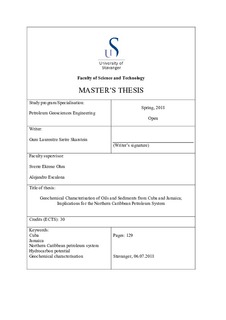| dc.description.abstract | The Caribbean plate has a complex tectonic history and its petroleum potential is relatively unexplored. Jamaica and a large part of Cuba were once part of the Great Arc of the Caribbean (GAC), which was later deformed as a result of two collisional events; Jamaica with the Chortis block during Latest Cretaceous and Cuba with the North American plate during the Paleocene. Due to the collision in the Paleocene, the stratigraphy of Cuba comprises rocks of both Caribbean and North American origins. The majority of the petroleum occurrences in northern Cuba are proposed to belong to a Gulf of Mexico (GOM) petroleum system.
This study presents detailed organic geochemical observations of fourteen crude oils and nineteen extracts from Cuba, as well as one crude oil, four extracts, and thirteen potential source rocks from Jamaica. The main goal is to investigate the petroleum system in the northern part of Caribbean. Analyses of oils and extracts by gas chromatography (GC), GC-mass spectrometry (GC-MS), GC-tandem mass spectrometry (GC-MSMS), and isotope analyses revealed alteration, facies, maturity, and age of the generating source rock. The geochemical results obtained were compared with published geochemical data from GOM and oils from the southern rim of the Caribbean plate (Barbados, Venezuela, and southeastern South America). In addition, Rock-Eval analysis gave information about source rock richness and maturity.
Organic geochemical data suggests that the Cuban and Jamaican oils can be divided into five oil families based on facies and age dependent biomarker ratios. Family I consists of oils derived from shales in northwestern Cuba, whereas Family II comprises oils originating from marls in the same area. The third (Family III) represents the oils generated by carbonates in central Cuba, Family IV includes the carbonate derived oils from southern Cuba, and Family V consists of the oils originating from marls in Jamaica. Furthermore, the presence of light oil fraction in biodegraded oils, as well as differences in maturity and facies between the oil fractions suggest the existence of at least two petroleum system in northwestern and central Cuba.
The regional geochemical comparison showed similarities in lithofacies and age with oils from GOM, suggests that the GOM petroleum system is working on northwestern Cuba. On the other hand, the Cuban and Jamaican oils appear to belong to different petroleum system than the oils from the southern margin of the Caribbean plate. Finally, the potential source rocks collected from Jamaica showed to have petroleum potential when buried sufficiently deep to attain the temperatures needed to generate petroleum. | nb_NO |
